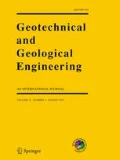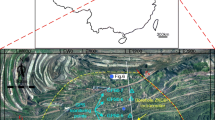Abstract
The locations of the 2013 eastern ShengLi open pit mine landslide and the 2010 northern ShengLi open pit mine landslide were both in the XilinHot city of Inner Mongolia province, in areas with similar geographical, regional geological, geomorphic conditions and excavation depth. There are so many similar characteristics, such as landslides triggered by the rain storms, landslides occurred many times, landslides with long time deformation, but there are also some differences between the two landslides, such as the scale and failure mode. Field investigations showed that the two landslides were both occurred several days after the rain storms, the eastern ShengLi open pit mine landslide body with the volume of 85 million m3 has been in persistent deformation with an observed maximum horizontal displacement of 58 m in August 2013, Furthermore the implemented check dams at east open pit mine had not formed an efficacious blocking system to resist the flow because of incorrect judgment regarding the landslide style. The northern ShengLi open pit mine landslide body with 0.5–1 million m3 occurred several times after each rain storm. In the whole, the time of persistent deformation about the eastern ShengLi open pit mine was much longer than that of the northern ShengLi open pit mine because of the difference of the filling material of fault and space combination between the faults and the slope. Field investigation, physical model experiments, real-time displacement monitoring and numerical simulation were implemented to investigate the characteristics, mechanism, and retaining measures of the two landslides. The insights gleaned herein may be valuable for the understanding of the mechanisms of landslides and improving preventative measures against these types of events in north China in the future.













Similar content being viewed by others
References
Acharya G, Cochrane TA, Davies T (2009) The influence of shallow landslides on sediment supply: a flume-based investigation using sandy soil. Eng Geol 109:161–169
Chanson H (2004) Sabo check dams-mountain protection systems in Japan. J River Basin Manag 2(4):301–307
Cruden DM (1991) A simple definition of landslide. Bull Int Assoc Eng Geol 43(1):27–29
Cuomo S (2014) New advances and challenges for numerical modeling of landslides of the flow type. Procedia Earth Planet Sci 9:91–100
Fan YB, Hou YF, Li SH (2013) Landslide stability analysis based on surface and deep displacement monitoring data. J Eng Geol 21(6):885–891
Feng C, Li SH, Liu XY, Zhang YN (2014) A semi-spring and semi-edge combined contact model in CDEM and its application to analysis of Jiweishan landslide. J Rock Mech Geotech Eng 6(1):26–35
Hitoshi S, Daichi N, Hiroshi M (2010) Relationship between the initiation of a shallow landslide and rainfall intensity-duration thresholds in Japan. Geomorphology 118:167–175
Huang CC, Chien LL, Jang JS (2008) Internal soil moisture response to rainfall-induced slope failures and debris discharge. Eng Geol 101:134–145
Li SH (2013) Progressive failure constitutive model of fracture plane in geo-material based on strain strength distribution. Int J Solids Struct 50(3–4):570–577
Pánek T (2013) Holocene reactivations of catastrophic complex flow-like landslides in the Flysch Carpathians (Czech Republic/Slovakia). Quat Res 80:33–46
Qi SW, Yan FZ, Wang SJ (2006) Characteristics, mechanism and development tendency of deformation of Maoping landslide after commission of Geheyan reservoir on the Qingjiang River, Hubei Province, China. Eng Geol 86:37–51
Qu YZ, Hao ZD, Bao JM (2009) Stability analyzing about south working slope in Shengli open- pit mine. Opencast Min Technol 02:16–22
Shu JS (2009) The slope stability analyzing and controlling about the ShengLi east open pitmine, 1–15 (in Chinese)
Sun XH, Shu JS, Guo BB (2008) Probing into eastern working slope south part landslide mechanism in Shengli open- pit mine. Opencast Min Technol 04:14–16
Varnes DJ (1958) Landslide types and processes. Highway research board special report, vol 29, pp 20–47
Varnes DJ (1984) Landslide hazard zonation: a review of principles and practice. Nat Hazards 3:1–56
Wang GL (2013a) Lessons learned from protective measures associated with the 2010 Zhouqu debris flow disaster in China. Nat Hazards 69:1835–1847
Wang LX (2013b) A GPU-based parallel procedure for nonlinear analysis of complex structures using a coupled FEM/DEM approach. Math Probl Eng 61(8):1–15
Wang GL (2014) Comparison of the landslides triggered by the 2013 Lushan earthquake with those triggered by the strong 2008 Wenchuan earthquake in areas with high seismic intensities. Bull Eng Geol Environ. doi:10.1007/s10064-014-0574-z
Wang GH, Sassa KJ (2003) Pore-pressure generation and movement of rainfall-induced landslides: effects of grain size and fine-particle content. Eng Geol 69:109–125
Wang J, Li SH, Zhang QB (2015) Simulation of crack propagation of rock based on splitting elements. Chin J Theor Appl Mech 47(1):1–14
Zeng QL, Yue ZQ, Yang ZF, Zhang XJ (2009) A case study of long-term field performance of check-dams in mitigation of soil erosion in Jiangjia stream, China. Environ Geol 58:897–911
Zhou JW, Xu WY, Yang XG et al (2010) The 28 October 1996 landslide and analysis of the stability of the current Huashiban slope at the Liangjiaren Hydropower Station, Southwest China. Eng Geol 114:45–56
Acknowledgments
The work presented in this paper was supported by the National Natural Science Foundation of China (11302229), the 973 Program (2010CB731506), and the National Nature Science Foundation of China (51274185 and 51374196). The authors are grateful for the support. We would like to thank Yang Zhou and ZhiYong Fan for their field investigation and physical model experiment. We also thank GenLong Wang for his linguistic assistance during the preparation of this manuscript. Finally, we would like to thank the Editor-in-Chief and three anonymous reviewers for their valuable comments on an earlier draft of this paper.
Author information
Authors and Affiliations
Corresponding author
Rights and permissions
About this article
Cite this article
Yongbo, F., Shihai, L., Yang, Z. et al. Lessons Learned from the Landslides in Shengli East Open-Pit Mine and North Open-Pit Mine in Xilinhot City, Inner Mongolia Province, China. Geotech Geol Eng 34, 425–435 (2016). https://doi.org/10.1007/s10706-015-9954-9
Received:
Accepted:
Published:
Issue Date:
DOI: https://doi.org/10.1007/s10706-015-9954-9




